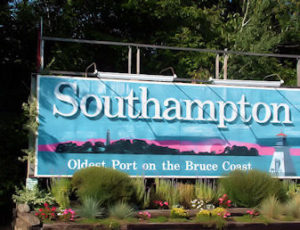
Long before settlers arrived to the area, Southampton was an important fur trading area.
In 1818, Pierre Piche arrived at the mouth of the Saugeen River and, by 1826, the Hudson’s Bay Company established an outpost at saguingue.
The first European settlers to arrive in the area, around 1848, were Captain John Spence and William Kennedy.
The first post office, the first and only in Bruce County for several years, was established in 1851 and was known as Saugeen and a year later, the first school opened. Three years later, the Bank of Upper Canada was built.
By 1861, Southampton on the shore of Lake Huron was a thriving community with grist mills, grain warehouses, shipping, five hotels, a sash and door factory, four churches and more.
The village was incorporated in 1858 and it was hoped that it would become the seat of the County of Bruce that had been formed on January 1, 1850. The new county was named after James Bruce, the eighth Earl of Elgin and Canada West’s Governor General (the Dominion of Canada did not exist). At the end of the day however, Walkerton won out as the central seat of Bruce County.

Among the many entrepreneurs in Southampton at the time, was John Denny who operated a grist mill at ‘Indian Rapids’, now Denny’s Dam. He also owned a sawmill that produced 150,000 feet of lumber annually, primarily hemlock, a sawmill, a woolen mill and an inn, which today is a private residence.
Four other businessmen had large grain warehouses along the river each with a wharf to transfer grain to ships in the harbour. It was estimated that, in the Spring of 1861, some 100,000 bushels of wheat were shipped. Among the four businessmen, was James Calder, who was the first Reeve of the village in 1858 and whose descendants still live in Southampton.
The four churches at that time were the Church of England, the Free Church (Presbyterian), N .C. Methodist and Wesleyan Methodist.
Hotels in 1861 were also a large part of the economy. According to records, the Hilberts owned the Hilbert Hotel that then became the Masonic Arms Hotel that became the Central Hotel and which, today, is known as the Walker House. There was also the Gilberts Hotel that became the Royal, then the Commercial, then the Southampton Hotel and, today, is the Outlaw Brewing Co. There were also at least four to five more in the village.
Southampton, now recognized as the oldest port on Lake Huron, was a very busy port in the 1800s. A regular steamer service was started in 1856 connecting Southampton to Goderich, that operated into the 1900s, and also to Collingwood. It was a time when the lakes were the highways when it came to transporting people, goods and produce. From lumber to wheat, Southampton became a major shipping port.
The mighty Saugeen River was a divide between north and south in Southampton and, without a bridge to connect the two sides, a ferry scow was built by Alfred Ditton and was operated by Charles Forrest who came from Ireland. Before winter set in, the scow would be pulled from the river at a cost of $10.
By 1861, the Morning Star newspaper was already several years old and it had replaced The Pioneer weekly. By 1862 however, it was gone and in its place, the Bruce Vindicator was being published by Francis H. Lynch-Staunton.
The next episode will feature Francis Lynch-Staunton …
————————————————-
From a very good friend, Doug Johnson, author and publisher of ‘There at the Beginning’, this is an encapsulation of Southampton. Doug is no longer with us but he presented his book to me several years ago with permission to tell the story, particularly, of Francis Lynch-Staunton











